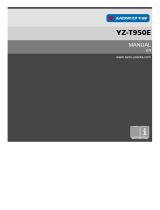6
Illustration Index
Illustration 2.1: Install USB drivers: Windows XP, Step 1 .................................................................. 16
Illustration 2.2: Install USB drivers: Windows XP, Step 2 .................................................................. 16
Illustration 2.3: Install USB drivers: Windows XP, Step 3 .................................................................. 17
Illustration 2.4: Install USB drivers: Windows XP, Step 4 .................................................................. 17
Illustration 2.5: Install USB drivers: Windows XP, Step 5 .................................................................. 18
Illustration 2.6: Install USB drivers: Windows XP, Step 6 .................................................................. 18
Illustration 2.7: Uninstall USB drivers: Windows XP, Step 1 .............................................................. 19
Illustration 2.8: Uninstall USB drivers: Windows XP, Step 2 .............................................................. 19
Illustration 2.9: Uninstall USB drivers: Windows XP, Step 3 .............................................................. 20
Illustration 2.10: Uninstall USB drivers: Windows XP, Step 4 ............................................................ 20
Illustration 2.11: Uninstall USB drivers: Windows XP, Step 5 ............................................................ 21
Illustration 2.12: Install USB drivers: Windows Vista, Step 1 ............................................................ 22
Illustration 2.13: Install USB drivers: Windows Vista, Step 2 ............................................................ 22
Illustration 2.14: Install USB drivers: Windows Vista, Step 3 ............................................................ 23
Illustration 2.15: Install USB drivers: Windows Vista, Step 4 ............................................................ 23
Illustration 2.16: Install USB drivers: Windows Vista, Step 5 ............................................................ 23
Illustration 2.17: Update USB drivers on Windows Vista, Step 1 ....................................................... 24
Illustration 2.18: Update USB drivers on Windows Vista, Step 2 ....................................................... 24
Illustration 2.19: Update USB drivers on Windows Vista, Step 3 ....................................................... 25
Illustration 2.20: Update USB drivers on Windows Vista, Step 4 ....................................................... 25
Illustration 2.21: Update USB drivers on Windows Vista, Step 5 ....................................................... 26
Illustration 2.22: Update USB drivers on Windows Vista, Step 6 ....................................................... 26
Illustration 2.23: Update USB drivers on Windows Vista, Step 7 ....................................................... 27
Illustration 2.24: Uninstall USB drivers on Windows Vista, Step 1 .................................................... 28
Illustration 2.25: Uninstall USB drivers on Windows Vista, Step 2 .................................................... 28
Illustration 2.26: Install USB drivers on Windows 7 - Step 1 ............................................................. 29
Illustration 2.27: Install USB drivers on Windows 7 - Step 2 ............................................................. 29
Illustration 2.28: Install USB drivers on Windows 7 - Step 3 ............................................................. 29
Illustration 2.29: Install USB drivers on Windows 7 - Step 4 ............................................................. 30
Illustration 2.30: Install USB drivers on Windows 7 - Step 5 ............................................................. 30
Illustration 2.31: Install USB drivers on Windows 7 - Step 6 ............................................................. 31
Illustration 2.32: Install USB drivers on Windows 7 - Step 7 ............................................................. 31
Illustration 2.33: Install USB drivers on Windows 7 - Step 8 ............................................................. 32
Illustration 2.34: Install USB drivers on Windows 7 - Step 9 ............................................................. 32
Illustration 2.35: Install USB drivers on Windows 7 - Step 10 ........................................................... 33
Illustration 2.36: Uninstall USB drivers on Windows 7 - Step 1 ......................................................... 34
Illustration 2.37: Uninstall USB drivers on Windows 7 - Step 2 ......................................................... 34
Illustration 5.1: Rear View of eXp 4500 ............................................................................................. 42
Illustration 5.2: Connection of probe ................................................................................................. 42
OKM GmbH
www.okmmetaldetectors.com


























